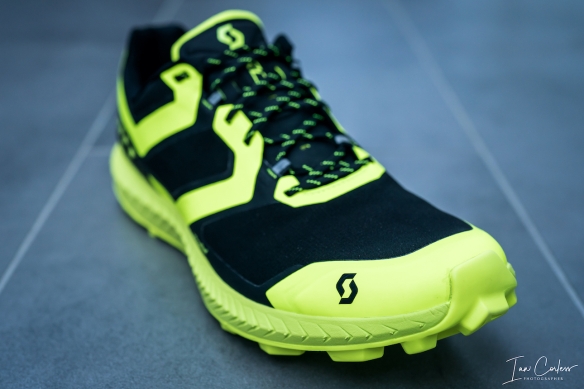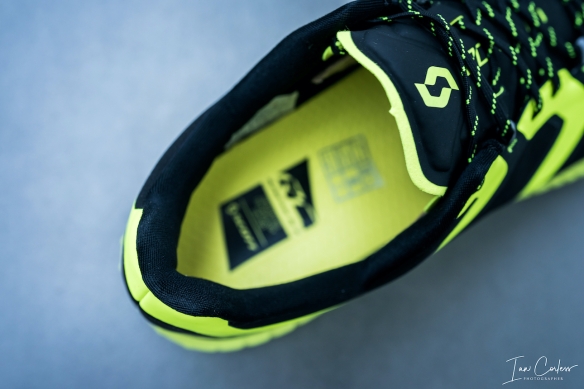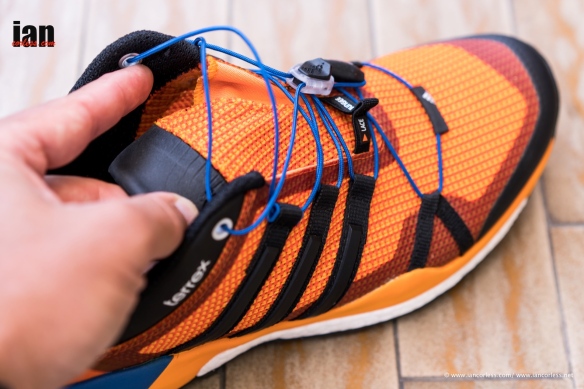
Scott have progressed year-on-year with the development of their trail running shoes. Notably, the interaction and feedback of their elite/ sponsored athletes have been instrumental in fine tweaking the range of shoes.
I have been fortunate to work with the brand as a photographer on multiple occasions, often photographing new shoes and apparel before they are released to the general public. It’s important to clarify here that when reviewing shoes/ apparel, I do so impartially.
I started using Scott in 2012, the original Kinabalu was a shoe I loved. Eight years on, the present day Kinabalu has little resemblance to the original, gladly, it has progressed and what was a good shoe years ago, is now, in my opinion, a top-quality trail shoe. Follow here for a review of the new Kinabalu Ultra RC which will be available in late July.

I first witnessed the Supertrac RC in 2016 and wrote a first impressions in November of that year, here.
The black and yellow look then was striking and now, 4-years on, it is still striking and as such, Scott athletes, Scott apparel and Scott shoes are easily identifiable on the trail. It was a smart move by the brand.

As great as the original RC was (is) it was not the perfect shoe for me. I had some issues with how low the lacing came and in the propulsive face, I would some minor irritation. I also found the shoe a little lifeless. The cushioning did not give me the bounce I had hoped for. Despite these points, the shoe was an incredible performer in mountain terrain providing grip, a responsive feel and the seamless upper were all winners! It was designed for skyrunning.
When Scott asked me to test out the new Supertrac RC 2 I was excited. I was surprised, to be honest, that the new incarnation had been so long coming. I had great expectations and although hopeful that the look/ integrity of the original shoe had not been changed, I had hoped that I would feel a notable difference.

Out of the box, I was happy. Black and yellow and this new shoe looked like the Supertrac I know. It was a great start. Flipping the shoe over, the 6mm lugs of the original were there, but the arrangement was different with a noticeable gap in the midfoot. I also noticed that the toe box was wider. The upper had several bales hanging off it, ‘3XDRY’ and ‘coldblack,’ so, it was apparent that the shoe had had an overhaul.
As a note, the new Kinabalu Ultra RC is being released in July and this, along with the Supertrac RC 2 is significant. The two shoes are very similar, the exception coming with the outsole and a more breathable/ mesh upper on the Kinabalu. In simple terms, the Supertrac RC 2 is for mountain, mud and rough terrain. The Kinabalu Ultra RC is a trail shoe.

Supertrac RC 2 on the top and the Kinabalu Ultra RC below – the difference in upper is significant. But fit/ feel is very similar.

The Kinabalu Ultra RC on top is less aggressive.
THE SHOE
I use an EU44 (UK9.5) for all my test shoes and weirdly, the Supertrac RC 2 although an EU44 says UK9 inside? I was perplexed initially thinking that the shoe would be too small. It’s not. So, if purchasing, just be careful with sizing. I am not sure why there is a discrepancy between EU and UK size.
At 298g for an EU44, this is a lightweight, but not the lightest mountain shoe.

One of the great attributes of the original Supertrac was foothold and here in the Supertrac RC 2 that foothold is equaled and bettered. Surprisingly, there is still no sock-like fit but when you slide the shoe on, you don’t even think about it. The seamless upper, tongue and lacing configuration hold the foot wonderfully tight. So, on technical terrain, there are no worries of one’s foot moving inside the shoe.

Key changes come in the upper with SCHOELLER COLDBLACK® and 3XDRY® which provide more protection and comfort. I was initially worried that the upper looked unbreathable and therefore potentially making the shoe hot, not so. The SCHOELLER COLDBLACK® reduces heat buildup and increases wearing comfort. The 3XDRY® is water and stain resistant and from the inside, it absorbs and distributes moisture.

The heel area is padded, snug and importantly when climbing does not allow for any slipping.

Notably, the toe box is wider allowing a little more toe splay than the original shoe and this is welcome. Toe protection is adequate and what is immediately noticeable is how the outsole rises up placing one lug almost on the toes – perfect for climbing.
Cushioning is notable. I found the original Supertrac lacking life and bounce, not here in the version 2 with the AEROfoam+. The bounce is notable even without running. The drop is 5mm.
Scott have always used eRide (rocker) to help with technique and cadence. In some models, it has been very noticeable. Here in the Supertrac RC 2 it is less noticeable, and the curvature is reduced.

The outsole has always been a selling point with ‘radial traction.’ The 6mm lugs fit the middle ground off aggressive, but not too aggressive and the lugs now have been spaced differently to help dispel mud and reduce clogging. Particularly noticeable in the middle of the outsole.
 If you wanted a shoe just for mud, then a more aggressive outsole would be better. But the Supertrac RC 2 quite rightly wants to provide a great all-rounder that handles mud, technical terrain and can still be comfortable when cruising some single-track.
If you wanted a shoe just for mud, then a more aggressive outsole would be better. But the Supertrac RC 2 quite rightly wants to provide a great all-rounder that handles mud, technical terrain and can still be comfortable when cruising some single-track.
IN USE
This is Scott’s best shoe so far in my opinion. The changes they have made addressed all my minor niggles from the original Supertrac RC and they have packaged them in a version 2 that is magical to wear.

I have given mine a real battering and in the space of a couple of weeks managed to get well over 100km in them in the mountains of Norway. Mud, trail, rock, wet and dry, at all times the shoes were performing at the highest level.
From 3-hour faster runs to 7-hour+ adventures, at all times, the shoes were comfortable and secure.
In the previous Supertrac RC, I would only use them for shorter/ faster outings, the v2 is so much more cushioned that even on continually hard and rocky terrain, I had all day comfort.
The outsole performed as expected offering secure grip on rocks both in the dry and wet. I had one issue of slipping continuously on a particular type of rock, however, it became clear that the green slime over it was an issue for any shoe and not just the Scott. Confirmed by a run friend who was in a pair of inov-8.
In mud, I was happy with the grip knowing only too well that if I got in continuous sloppy and deep mud that grip would be compromised a little due to the 6mm lugs. But, the new spacing of the lugs did the job of expelling mud. This was perfect in guaranteeing a more consistent grip for all the time.
When on technical and demanding trail, you need a shoe that holds the foot so you can be 100% sure. Many brands call this ‘precision’ and often one of the downsides of a precision shoe/ fit is that the toe box will be narrower. The Supertrac RC 2 has a wider toe box and it is noticeable. I was therefore worried that some of that firm hold and reassurance may be lost. No! The lacing and fit are so good, that you can adjust and tweak making sure that you have 100% security. Even the insole grips one’s sock.
I ran through a great deal of wet/ muddy and boggy ground and here is maybe one downside of the shoe. I felt drainage was compromised. I always wear Merino socks and so therefore had no issues with cold feet, even when running through a great deal of snow. However, I do feel water retention was more noticeable.

CONCLUSIONS
The Supertrac RC 2 is a great shoe and for anyone who loved the original Supertrac RC, I think now they will have an even bigger smile on their face.
For those who were tempted by the black and yellow shoes previously but decided that the toe box was too narrow, the cushioning compromised, or the feel was a little flat, you should now go back and check these out.
It’s rare I compare shoes to other brands and models, however, for those who have read my reviews, they will know that VJ Sport are my ‘go-to’ shoes for the mountains, be that the XTRM or MAXx models. Now, I firmly believe that Scott have a shoe that can compete.
I have 98% of good things to say about the Scott Supertrac RC 2 and the only negative is the potential for retaining water… To clarify, it does not stay in the shoe, it does dissipate. It just dissipates slower than I would have liked.

Please support this website. I believe everyone deserves to read quality, independent and factual articles – that’s why this website is open to all. Free press has never been so vital. I hope I can keep providing independent articles with your help. Any contribution, however big or small, is so valuable to help finance regular content. Please support me on Patreon HERE.
Follow on:
Instagram – @iancorlessphotography
Twitter – @talkultra
facebook.com/iancorlessphotography
Web – www.iancorless.com
Web – www.iancorlessphotography.com
Image sales –www.iancorless.photoshelter.com
















